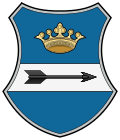Egeraracsa | |
|---|---|
Village | |
| Coordinates: 46°40′25″N17°04′40″E / 46.67366°N 17.07788°E | |
| Country | Hungary |
| Region | Western Transdanubia |
| County | Zala |
| District | Keszthely |
| Area | |
• Total | 7.03 km2 (2.71 sq mi) |
| Population (1 January 2024) [1] | |
• Total | 322 |
| • Density | 46/km2 (120/sq mi) |
| Time zone | UTC+1 (CET) |
| • Summer (DST) | UTC+2 (CEST) |
| Postal code | 8765 |
| Area code | (+36) 83 |
| Website | egeraracsa |
Egeraracsa is a village in Zala County, Hungary. It is located near the lake Kis-Balaton.




